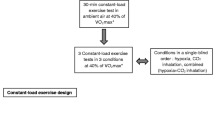Abstract
We examined the effects of exercise training on pulmonary arterial blood pressure (Ppa) and on adenosine 3′,5′-cyclic monophosphate (cAMP) and guanosine 3′,5′-cyclic monophosphate (GMP) concentrations in lung tissue at rest and during exercise under hypoxic conditions in catheter-implanted rats. Male Wistar rats were divided into an exercise-trained group (ET, n = 32) and nonexercised control group (control, n = 32). ET rats exercised 40 min/day 6 days/week for 6 weeks, at an altitude of 610 m on a treadmill. The mean Ppa levels of the ET were significantly lower than those of controls at rest and during exercise at 610- and 2500-m altitudes. The exercise-induced mean Ppa increase in the ET was less than that in controls at both 610- and 2500-m altitudes. Resting lung cAMP increased more in the ET than in controls at both 610- and 2500-m altitudes. In ET, cGMP was significantly greater at the 2500-m altitude than at the 610-m altitude at rest and just after exercise. Hypoxic exercise in ET was accompanied by a preferential increase in cGMP but not in cAMP. These results suggest that the intracellular augmentation of cAMP and cGMP in ET plays an important role in attenuating hypoxic pulmonary vasoconstriction (HPV) and exercise-induced increases in Ppa.
Similar content being viewed by others
References
Bar H (1974) Cyclic nucleotides and smooth muscle. Adv Cyclic Nucleotide Res 3:195–237
Burke TM, Wolin MS (1989) H2O2 and cGMP may function as an O2 sensor in the pulmonary artery. J Appl Physiol 60:167–170
Chang S, Sakai A, Voelkel NF (1989) Dibutyryl-cAMP blocks endotoxin-induced lung injury in rats. Am Rev Respir Dis 140:1814–1817
Elkins RC, Milnor WR (1971) Pulmonary vascular response to exercise in the dog. Circ Res 29:591–599
Farrukh IS, Gurtner GH, Michael JR (1987) Pharmacological modification of pulmonary vascular injury: possible role of cAMP. J Appl Physiol 62:47–54
Fulton RM, Hutchinson EC, Jones AM (1952) Ventricular weight in cardiac hypertrophy. Br Heart J 14:413–420
Gabor MR, Romero JC, Vanhoutte PM (1986) Flow-induced release of endothelium-derived relaxing factor. Am J Physiol 250:H1145-H1149
Goldfarb AM, Kendrick ZV (1981) Effect of an exercise run to exhaustion on cAMP in the rat heart. J Appl Physiol 51:1539–1541
Kashimura O, Sakai A (1991) Effect of physical training on pulmonary arterial pressure during exercise under hypobaric hypoxia in rats. Int J Biometeorol 35:214–221
Kaukel E, Voelkel NF, Lanser K, Sill V (1978) Effects of hypoxia on pulmonary vascular reactions and on cyclic GMP in pigs. Biochem Pharmacol 27:911–914
Kovitz KL, Aleskowitch TD, Sylvester JT, Flavahan NA (1993) Endothelium-derived contracting and relaxing factors contribute to hypoxic responses of pulmonary arteries. Am J Physiol 265:H1139-H1148
Laughlin MH, McAllister RM (1992) Exercise training-induced coronary vascular adaptation. J Appl Physiol 73:2209–2225
Lehmann MK (1986) Alpha2-adrenoreceptor density on intact platelets and adrenaline-induced platelet aggregation in endurance and nonendurance-trained subjects. Int J Sports Med 71: 172–176
Musshoff K, Reindell H, Klepzig H (1959) Stroke volume, arteriovenous difference, cardiac output and physical working capacity and their relationships to heart volume. Acta Cardiol 14:427–431
Rhoades RA, Morrow RP, Eskew ML (1976) Lung cyclic AMP: selective decrease with hypoxia. Proc Soc Exp Biol Med 52:480–482
Sill V, Kaukel E, Voelkel NF, Siemssen J (1974) The significance of cyclic 3′,5′ AMP for the Euler-Liljeestrand mechanism. Pneumonologie 150:337–344
Wang J, Wolin MS, Hintze TH (1993) Chronic exercise enhances endothelium-mediated dilation of epicardial coronary artery in conscious dogs. Circ Res 73:829–838
Author information
Authors and Affiliations
Additional information
Offprint requests to: Osamu Kashimura
Rights and permissions
About this article
Cite this article
Kashimura, O., Sakai, A. Lung cyclic nucleotides in exercise-trained rats attenuate hypoxic pulmonary vasoconstriction. Lung 173, 363–372 (1995). https://doi.org/10.1007/BF00172143
Accepted:
Issue Date:
DOI: https://doi.org/10.1007/BF00172143




